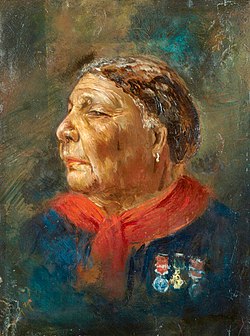
A portrait of Mary Seacole in oils, c. 1869, by the obscure London artist Albert Charles Challen
Hat tip: Paula Dozier
Black women in Europe who are interested in nursing are invited to join Paula’s Spirit of Seacole group on the Black Women in Europe Social Network.
Source: Wikipedia
Mary Jane Seacole (1805 – 14 May 1881), sometimes known as Mother Seacole or Mary Grant, was a Jamaican nurse best known for her involvement in the Crimean War. She set up and operated boarding houses in Panama and the Crimea to assist in her desire to treat the sick. Seacole was taught herbal remedies and folk medicine by her mother, who kept a boarding house for disabled European soldiers and sailors.
Confident that her knowledge of tropical medicine could be useful, and after hearing of poor medical provisions for wounded soldiers during the Crimean War, she travelled to London to volunteer as a nurse. Relying on her experience in the Caribbean, she applied to the War Office and asked to be sent as an army assistant to the Crimea. She was refused, mainly because of prejudice against women’s involvement in medicine at the time.
The British Government later decided to permit women to travel to the affected area, but she was not included in the party of 38 nurses chosen by Florence Nightingale. Instead, she borrowed money to make the 4,000-mile (about 6500 km) journey by herself. She distinguished herself treating battlefield wounded, often nursing wounded soldiers from both sides while under fire. When the conflict ended in 1856 she found herself stranded and almost destitute, and was only saved from adversity by friends from the Crimean War who organised a benefit concert. In later years, she expressed a desire to work in India after the Indian Rebellion of 1857, but was unable to raise the necessary funds.
Seacole was honoured in her lifetime, alongside Florence Nightingale, but after her death she was forgotten for almost a century. Today, she is noted for her bravery and medical skills and as “a woman who succeeded despite the racial prejudice of influential sections of Victorian society”. Her autobiography, Wonderful Adventures of Mrs. Seacole in Many Lands (1857), is a vivid account of her experiences, and is one of the earliest autobiographies of a mixed-race woman.
Read the full Mary J. Seacole biography.

I really proud of her and her medical skills in nursing. Thanks for sharing this article.
You are welcome.